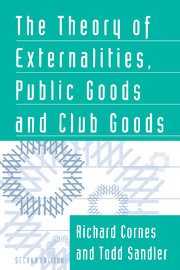Book contents
- Frontmatter
- Contents
- List of tables and figures
- Preface
- Part I Introduction to the theory of externalities, public goods, and club goods
- Part II Externalities
- Part III Public goods
- Part IV Clubs and club goods
- Part V Applications and future directions
- 17 Empirical estimation and public goods
- 18 Applications and empirics
- 19 Conclusions and directions for future research
- References
- Author index
- Subject index
19 - Conclusions and directions for future research
Published online by Cambridge University Press: 05 June 2012
- Frontmatter
- Contents
- List of tables and figures
- Preface
- Part I Introduction to the theory of externalities, public goods, and club goods
- Part II Externalities
- Part III Public goods
- Part IV Clubs and club goods
- Part V Applications and future directions
- 17 Empirical estimation and public goods
- 18 Applications and empirics
- 19 Conclusions and directions for future research
- References
- Author index
- Subject index
Summary
A great deal of ground has been covered in eighteen chapters. Starting from the general notion of an externality, we have examined specific types of externalities, including pure public goods, impure public goods, and club goods. For each, we have presented and reviewed alternative modeling representations, their comparative statics, their optimality conditions, pertinent institutional arrangements (including preference-revelation mechanisms), empirical investigations, and applications. In addition, we have investigated whether or not independent behavior can be expected to yield Pareto-optimal results. For nonoptimal independent behavior, as in the case of pure public goods, we have studied the efficacy of policies (e.g., taxfinanced government provision, redistribution policies, Lindahl bargaining, and other procedures) to correct for inefficiencies. The roles of transaction costs, information asymmetries, and institutional design have been addressed for a host of public good/externality scenarios.
To highlight the importance of the theory, we have presented many applications both in the earlier chapters and in the chapter devoted to applications and empirics. In this edition, an increased emphasis has been placed on game-theoretic concepts that underlie the study of externalities, public goods, and club goods. Finally, we have greatly expanded our coverage of externalities and their implications.
In the first edition, we presented an agenda for future research. We are pleased that many of our earlier research suggestions (e.g., an analysis of multiproduct clubs, further analysis of mixed clubs and the core, the development of the joint-product model, the implementation of applications of the joint-product model, further study of heterogeneous groups and public goods, additional work on non-Nash equilibria, and additional study of uncertainty and clubs) have been taken up.
- Type
- Chapter
- Information
- The Theory of Externalities, Public Goods, and Club Goods , pp. 536 - 552Publisher: Cambridge University PressPrint publication year: 1996



